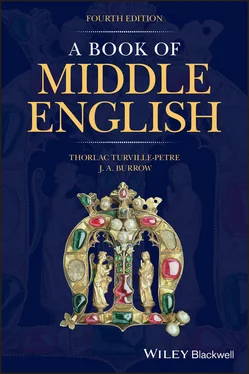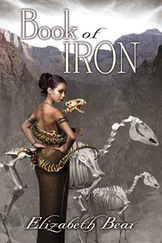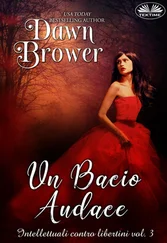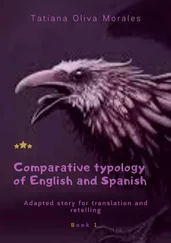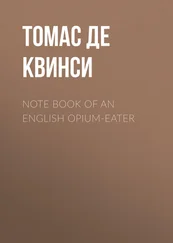What follows is no more than a rough guide, to enable readers to produce or imagine approximately the right sounds. These are indicated between slashes (/ /). Where modern equivalents are given, these are drawn from standard British English (RP, ‘Received Pronunciation’). For fuller accounts of Middle English phonology, see Blake (1992) and Jordan in Bibliography 9.2 below.
2.2 Vowels
2.2.1 The Long Vowels
The main system of long vowel sounds in Middle English was as follows (a colon indicates length):
| /a:/ |
as in modern ‘father’ |
| /ε:/ |
as in French ‘bête’ (‘open e ’, roughly as in modern ‘there’) |
| /e:/ |
as in French ‘thé’ (‘close e ’, roughly as in modern ‘say’) |
| /i:/ |
as in modern ‘see’ |
| /ɔ:/ |
roughly as in modern ‘broad’ (‘open o ’) |
| /o:/ |
as in French ‘eau’ (‘close o ’, roughly as in modern ‘go’) |
| /u:/ |
as in modern ‘do’ |
The following Middle English words illustrate typical ways of representing these sounds:
save and caas (modern ‘case’) have /a:/
lene, heeth and death commonly have /ε:/
nede and sweete have /e:/
fine and shyne have /i:/
holy and oon (modern ‘one’) have /ɔ:/
foot and mone (modern ‘moon’) have /o:/
hous and lowde have /u:/
Three observations may be added. The long open e , /ε:/, was unstable: words such as lene commonly have variants with the long close vowel, /e:/. Secondly, neither the distinction between open and close long e nor that between open and close long o is regularly marked by Middle English spelling. Modern spellings are a better guide, in cases where the word survives. Thus ‐ee‐ and ‐oo‐ in modern words (e.g. ‘feet’, ‘moon’) frequently indicate a close vowel in the Middle English word. Similarly, ‐ea‐ and ‐oa‐ in modern words (e.g. ‘heath’, ‘boat’) frequently indicate earlier open vowels. Finally, it should be noted that two of our early texts, nos 1 and 3, employ the Old English vowel symbol æ (known as ‘ash’), most often for /ε:/, but also for /a:/.
It will be seen that in Middle English spellings the letters a , e , i , o , and u , when they represent long vowels, have values very different from those in Modern English. But it is Modern English which is out of line here. Middle English scribes followed Latin usage (going back to the time when Anglo‐Saxon was first written in the Latin alphabet) and also, to a lesser extent, French. This is the usage which still prevails in the writing of French and other continental languages. English is now ‘out of line’ as a result of a series of changes which affected all the English sounds in question during the fifteenth, sixteenth and seventeenth centuries: the so‐called Great Vowel Shift. Thus, Middle English /a:/ shifted to /e:/; but the words in which it occurred (‘case’, ‘name’ etc.) preserved their old a spelling. Similar changes affected the sounds but not the spellings of the other Middle English long vowels. So, by the eighteenth century:
| /a:/ |
became /e:/ and later the diphthong /ei/ (modern ‘name’) |
| /ε:/ |
became either /e:/ (modern ‘break’) or more often /i:/ (modern ‘heath’) |
| /e:/ |
became /i:/ (modern ‘see’) |
| /i:/ |
became the diphthong /ai/ (modern ‘time’) |
| /ɔ:/ |
became /o:/ (modern ‘boat’) |
| /o:/ |
became /u:/ (modern ‘moon’) |
| /u:/ |
became the diphthong /au/ (modern ‘house’) |
The letters e and i or y , where they represent short vowels in words such as Middle English hell , pit or synne , are to be pronounced as in Modern English. The letter a is always to be pronounced /a/ as in French ‘patte’, not as in the modern ‘cat’ (in Received Pronunciation). The letter æ (in nos 1 and 3 only), where it represents a short vowel, signifies either /a/ or /e/. The letter u is always to be pronounced /u/ as in modern ‘put’, even in words whose modern descendants have the sound of ‘cut’; but where the modern descendant has an e or i (as in ‘merry’ for the Western Middle English murie , or ‘kin’ for Western kunne ), the u is to be pronounced as in French ‘du’. The letter o is normally much as in Modern English ‘God’; but it also acts as a spelling for /u/ in words such as yong or love (where modern usage commonly offers a guide).
2.2.3 Unstressed Final ‐e
In the spelling of modern words such as ‘name’, ‘fine’ and ‘nice’, the final letter ‐e serves to define the sound of the previous vowel and often also that of the intervening consonant. In Middle English spelling, however, it had a more straightforward function: to indicate a final e sound. Sometimes it represents the sound /e:/, in which case it is distinguished in this book by an acute accent ( pité , pronounced /pite:/). But its main function was to represent the unstressed final /ǝ/, as in the second syllable of modern ‘China’. Thus, in the poetry of Gower, a word such as name will have two syllables, /na:mǝ/, except where the final vowel is lost before a following word which begins with a vowel or some kinds of h‐ (see 6.2 below). There was, however, a tendency for /ǝ/ to be lost in such unstressed positions, especially in more northerly dialects. Hence the rhymes of the Gawain ‐poet indicate a northerly usage varying between pronounced and silent final ‐e : compare the rhymes in 9/176, 178 and 9/413, 415 here.
One may start with the assumption that, in Middle English spelling, combinations of vowel‐letters such as ai or au represent (as they rarely do in modern spelling) sequences which begin with the sound indicated by the first letter and end with the sound indicated by the second. Thus, Middle English day was pronounced with /a/ + /i/, as a single syllable, much like modern ‘die’; and Middle English cause has the diphthong of modern ‘cow’, /a/ + /u/. Similarly, eu or ew represent an e sound followed by /u/, which is also as it should be. But note the following:
1 ei originally represented /e/ + /i/; but this diphthong developed into /a/ + /i/ in the thirteenth century. So alwey rhymes with may thereafter.
2 oi commonly represented /o/ + /i/, but also sometimes /u/ + /i/. The two diphthongs occur as alternatives in certain words, e.g. boy.
3 ou or ow represented /o/ + /u/ in such words as foughten; but in words now pronounced with /au/, like ‘house’, they represented /u:/. (See 2.2.1 above.)
4 ea and eo spellings do not represent diphthongs in Middle English, though they had done so in Old English. In each case, the Old English diphthong has become a single vowel sound in Middle English, while retaining the two‐letter spelling. So Middle English ea represents /ε:/; and eo represents /e/ when short, and /e:/ when long. In Early Middle English writings of Western origin such as Laʒamon’s Brut or Ancrene Wisse (texts 3 and 4 here), however, eo is to be pronounced like the vowel in French ‘peuple’ (short or long).
Читать дальше
